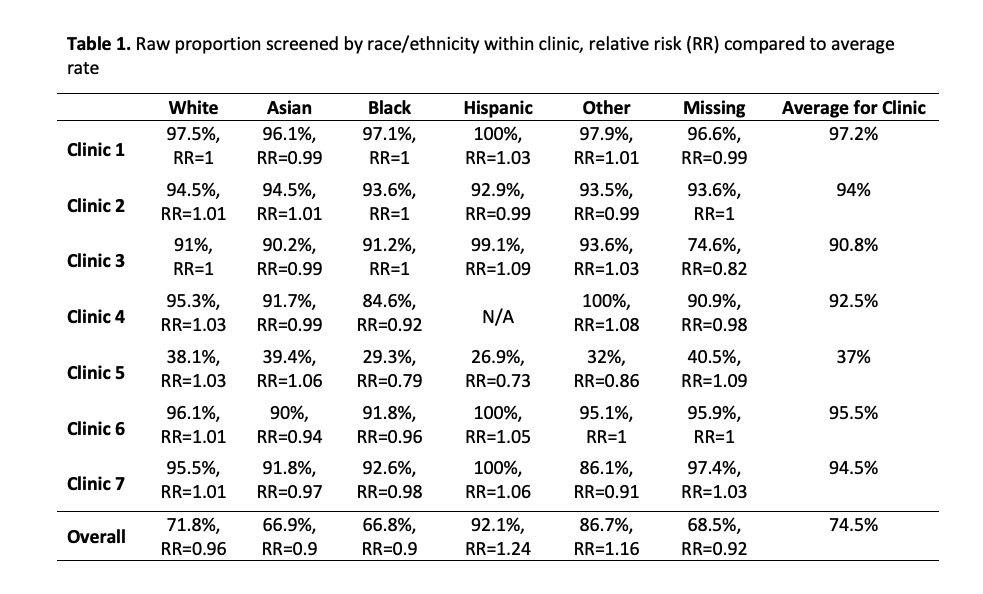Developmental and Behavioral Pediatrics: Screening & Assessment
Category: Abstract Submission
Developmental and Behavioral Pediatrics: Equity
67 - Racial/Ethnic Disparities in Rates of Behavioral Screening: A Case of Simpson’s Paradox
Saturday, April 23, 2022
3:30 PM - 6:00 PM US MT
Poster Number: 67
Publication Number: 67.202
Publication Number: 67.202
Talia S. Benheim, Massachusetts General Hospital, Boston, MA, United States; Chris Sheldrick, Boston University, Boston, MA, United States; Ellen C. Perrin, Tufts Childen's Hospital, Brookline, MA, United States; Anamika Dutta, Massachusetts General Hospital, Somerville, MA, United States; Michael Murphy, Harvard Medical School, Acton, MA, United States

Chris Sheldrick, PhD
Associate Professor
Boston University
Boston, Massachusetts, United States
Presenting Author(s)
Background: In recent years, the 7 outpatient pediatric clinics affiliated with Massachusetts General Hospital have implemented an electronic system to facilitate screening patients aged 2 months to 17 years for psychosocial problems using the Baby Pediatric Symptom Checklist, the Preschool Pediatric Symptom Checklist, or the Pediatric Symptom Checklist-17.
Objective: To examine racial/ethnic disparities in psychosocial screening across clinics.
Design/Methods: A total of 20,530 well-child visits (WCVs) took place in the 7 clinics between June 3 and December 31, 2019. WCVs were defined as having a completed screen if there was evidence of a screen in the electronic medical record (EMR) and/or a bill for a screen. Analyses controlled for child age, language, insurance type, and clinic.
Results: On average, 74.5% of WCVs had evidence of a screen. Six of the 7 clinics had screening rates above 90.2%, while one clinic had a markedly lower screening rate of 37%. Screening rates across racial/ethnic groups ranged from 66.8% (Black) to 92.1% (Hispanic; Table 1). Overall, Asian patients were less likely to be screened (66.9% vs 74.5%), but differences were not apparent after adjusting for clinic. In contrast, Black patients within any given clinic did not have a significantly different likelihood of screening than that clinic's average screening rate (aRR=0.91-0.99, all p>.05). Yet overall, Black patients were found to have a slightly but significantly lower likelihood of screening than the average (80% vs. 83.5%, p < .05; Table 2).Conclusion(s): The association between race/ethnicity and screening was confounded by clinic—an example of Simpson’s Paradox. Given the clustering of racial/ethnic groups within clinics, reducing disparities in screening rates between clinics could have a measurable impact on improving equity in screening.
Table 1. Raw proportion screened by race/ethnicity within clinic, relative risk (RR) compared to average rate
Table 2. Adjusted proportion screened by race/ethnicity within clinic, relative risk (RR; adjusted for child age, insurance, and language) compared to average rate.png) *p < .05
*p < .05
Objective: To examine racial/ethnic disparities in psychosocial screening across clinics.
Design/Methods: A total of 20,530 well-child visits (WCVs) took place in the 7 clinics between June 3 and December 31, 2019. WCVs were defined as having a completed screen if there was evidence of a screen in the electronic medical record (EMR) and/or a bill for a screen. Analyses controlled for child age, language, insurance type, and clinic.
Results: On average, 74.5% of WCVs had evidence of a screen. Six of the 7 clinics had screening rates above 90.2%, while one clinic had a markedly lower screening rate of 37%. Screening rates across racial/ethnic groups ranged from 66.8% (Black) to 92.1% (Hispanic; Table 1). Overall, Asian patients were less likely to be screened (66.9% vs 74.5%), but differences were not apparent after adjusting for clinic. In contrast, Black patients within any given clinic did not have a significantly different likelihood of screening than that clinic's average screening rate (aRR=0.91-0.99, all p>.05). Yet overall, Black patients were found to have a slightly but significantly lower likelihood of screening than the average (80% vs. 83.5%, p < .05; Table 2).Conclusion(s): The association between race/ethnicity and screening was confounded by clinic—an example of Simpson’s Paradox. Given the clustering of racial/ethnic groups within clinics, reducing disparities in screening rates between clinics could have a measurable impact on improving equity in screening.
Table 1. Raw proportion screened by race/ethnicity within clinic, relative risk (RR) compared to average rate

Table 2. Adjusted proportion screened by race/ethnicity within clinic, relative risk (RR; adjusted for child age, insurance, and language) compared to average rate
.png) *p < .05
*p < .05